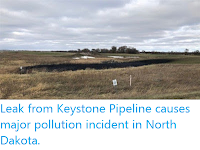Twelve families have been evacuated from homes in the Black Hawk area of Rapid City in Meade County, South Dakota, following the appearance of a sinkhole on Monday 27 April 2020. Since first appearing the hole has expanded to cover an area of about fifteen metres by twelve, as well as breaking water and sewer lines in the area, and there are concerns that if could expand further and present a structural threat to buildings in the area.
Sinkhole in the Black Hawk area of Rapid City, South Dakota. Associated Press.
Sinkholes
are generally caused by water eroding soft limestone or unconsolidated
deposits from beneath, causing a hole that works its way upwards and
eventually opening spectacularly at the surface. Where there are
unconsolidated deposits at the surface they can infill from the sides,
apparently swallowing objects at the surface, including people, without
trace.
On this occasion exploration of the hole by expert cavers revealed that it was caused by the collapse of part of an old and abandoned gypsum mine beneath the area. The mine is between seven and ten metres below the ground, and extends for over 180 m horizontally, with around 700 m of accessible passages, as much as twelve metres wide and four metres high. The mine is believed to have been excavated in the early 1900s, and used as a dump in the later twentieth century, with a variety of abandoned materials including a 1951 Ford motorcar found within the site. It is unclear if the developers that built houses above the site were aware of the presence of the mine.
A car found in an abandoned gypsum mine beneath Black Hawk, South Dakota. Dan Austin/Paha Sapa Grotto.
Gypsum is an evaporate rock, a form of calcium sulphate deposited as
mineral-rich water evaporates, often around sulphurous hot springs or
volcanic systems. It is a very soft rock, and soluble in water, so
moisture entering gypsum deposits can cause major collapses and
subsidence.
See also...
Follow Sciency Thoughts on Facebook.








